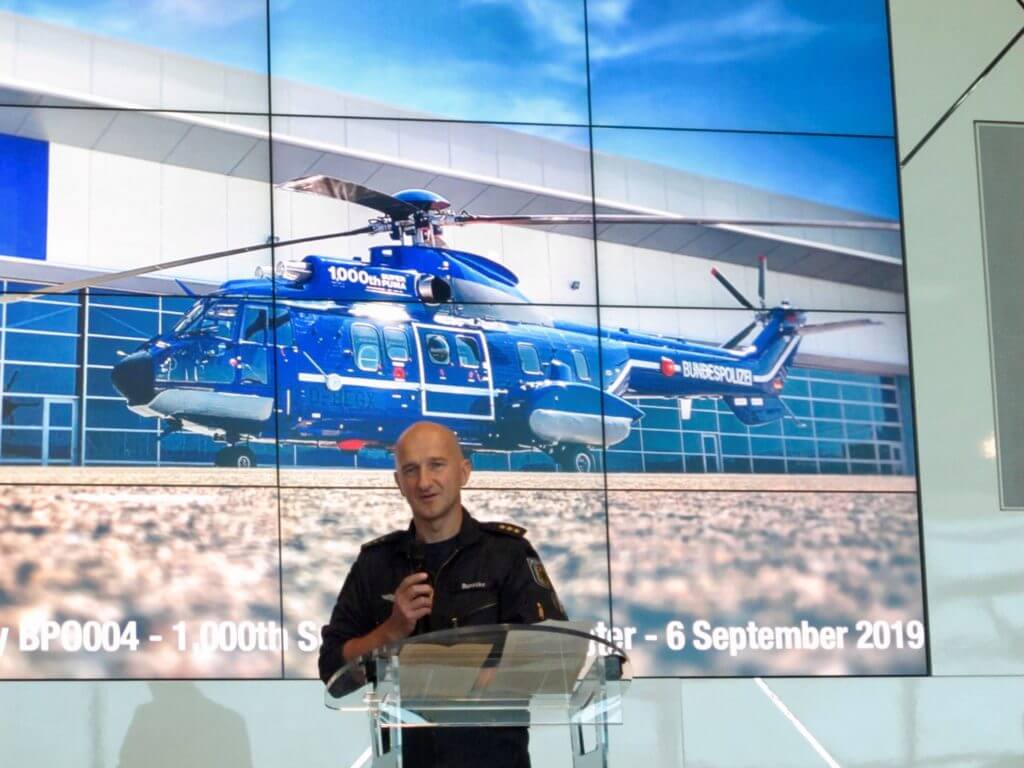The Super Puma program, once in the doldrums because of the downturn in the oil-and-gas sector and a four-month-long grounding in 2016, is now enjoying sustained activity.

Speaking on the occasion of the 1,000th delivery of a Super Puma family helicopter, Michel Macia, head of the program, said 80 examples of the heavy twin (in civil and military versions) are to be delivered by the end of 2021. The total backlog stands at 100.
The production rate is currently ramping up, although delivery cycles are anticipated to cause it to fluctuate, he said. A third assembly line is being created at the airframer’s Marignane factory to accommodate the additional production. Each line can put together both models, the lower-cost H215 and the more sophisticated H225.
Overall, Super Puma operators are flying “more than ever,” Macia said, referring to a 16 percent increase in flying activity over the past 12 months – the majority of the growth coming from the H225. The worldwide fleet has accumulated 5.6 million flight hours since the first delivery four decades ago. The in-service fleet stands at 714, spread over 95 operators.
Recent orders have come notably from the military and parapublic markets. Hungary, for instance, ordered 16 H225Ms in 2018. For the Japan Coast Guard, Airbus has to deliver another five H225s by the end of 2021.
The backlog is said to be balanced between civil and military aircraft. No booking from the oil-and-gas sector can be found in the order book. This is due to the ongoing downturn and the move to super medium rotorcraft, according to Macia.
Super Pumas are operating in the oil-and-gas sector in Asia and Latin America. Despite the technical resolution of the H225’s and AS332 L2’s main gearbox problems, confidence has yet to be regained with oil-and-gas passengers in the North Sea. In that region, however, some are flying for search-and-rescue missions.
The different versions of the Super Puma are said to be selling in a balanced fashion. Last year, deliveries were almost evenly split between the H215 and the H225. The H215’s longer fuselage variant enjoyed slightly more deliveries than the shorter one. As for the H225, the military version sold moderately faster than the civil one.

A major effort has been repurposing the 150-or-so aircraft that found themselves on the ground after the technical and economic crisis in 2015-2016. Airbus’s goal has been to limit the number of unused aircraft to avoid a too negative impact on the value of the average Super Puma. Contracts for the repurposing of 51 aircraft have been signed, 15 of which have been delivered. Opportunities for another 40 aircraft have been identified.
Repurposing can be relatively straightforward if the helicopter is to be operated in aerial work. It can be more complex when the new mission is to be combat search-and-rescue, like in the Ukrainian case.
The Super Puma program is on a stronger footing than three to four years ago but this is taking place against a backdrop of relatively slow sales in the global helicopter industry. The civil market “is still challenging,” Airbus Helicopters CEO Bruno Even said. Meanwhile, the military market is a market of renewal and opportunities, he added. Nevertheless, “I am confident for the medium and long term,” he said.
No successor to the Super Puma is in the pipeline. Early in 2018, Airbus Helicopters announced it would not launch the envisaged X6 program, citing insufficient maturity of some technologies and uncertain sales prospects for heavy helicopters in the long term. Even now says he sees the Super Puma selling “beyond 2030.”
Upgrades will continue to be integrated. New avionics are being developed in house for the H225M. The standard civil version now comes with cameras to monitor the boarding process, as well as watching the aircraft’s environment on the ground from the tailboom. The TCAS 2 system for automated collision avoidance is coupled with the autopilot.
A new 19-seat cabin layout was designed to help passengers move around more easily, while egress was made quicker thanks to new push-out window handles.
The 1,000th Super Puma was the last H215 in an order of four from the German Federal Police, which will use it to “manage maritime emergencies off Germany’s coast.”









